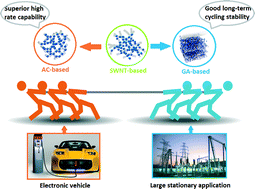Architecture–property relationships of zero-, one- and two-dimensional carbon matrix incorporated Na2Fe(SO4)2·2H2O/C†
Abstract
The correlations between properties and architecture are a central theme for electroactive materials in energy storage devices. We have conducted a systematic investigation on the relationship between the architecture and physicochemical characteristics of sulfate/C composites. Three types of carbon matrix, i.e. activated carbon (AC:0D), single wall carbon nanotubes (CNT:1D) and graphene (GA:2D) were employed to construct different structured sulfate/C composites. The discussion is focused on the relationship between the architecture and properties such as electronic conductivity, moisture absorption, sodium intercalation kinetics and the electrochemical performance of the sulfate/C composite. The Na2Fe(SO4)2·2H2O/AC composite has the largest electrode/electrolyte interface and the highest porosity, thus it allows the fastest ionic diffusion and the best high-rate capability. However, the sandwich-type Na2Fe(SO4)2·2H2O/GA composite has the most compact and toughest architecture, thus it allows the highest electronic conductivity and the lowest moisture sensitivity. The rational design principle for the Na2Fe(SO4)2·2H2O/C composite with desirable thermodynamic and kinetic characteristics was deduced from a comprehensive evaluation of the architecture–property relationships. We also propose the electron/ion diffusion pathway and moisture absorption mechanism found for the different architectures. The present study has potential application as a design guide for Na2Fe(SO4)2·2H2O/C composites in energy storage and conversion.


 Please wait while we load your content...
Please wait while we load your content...